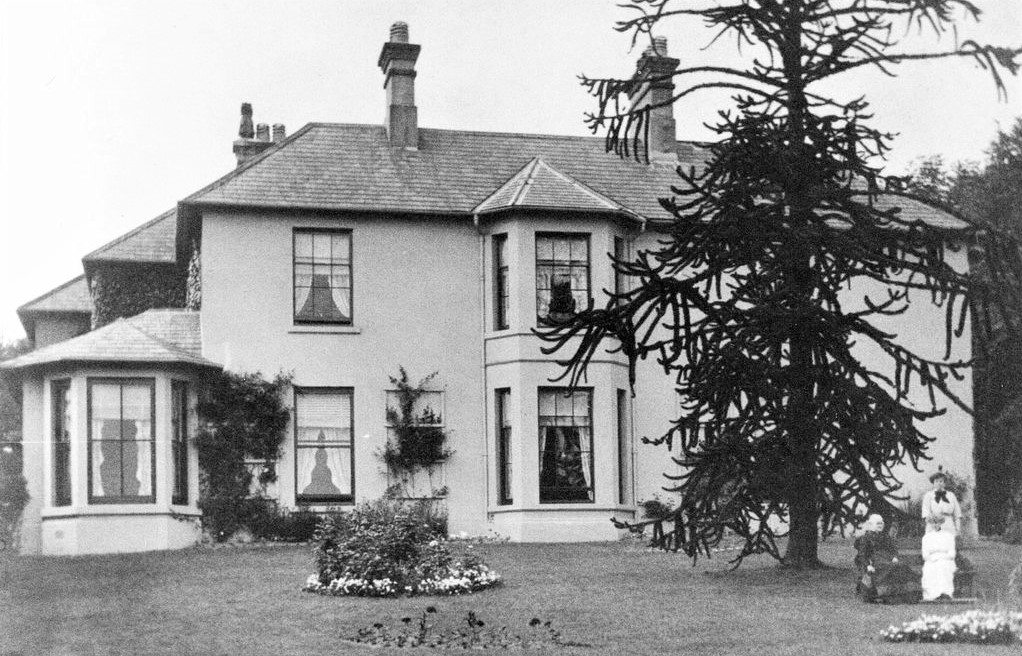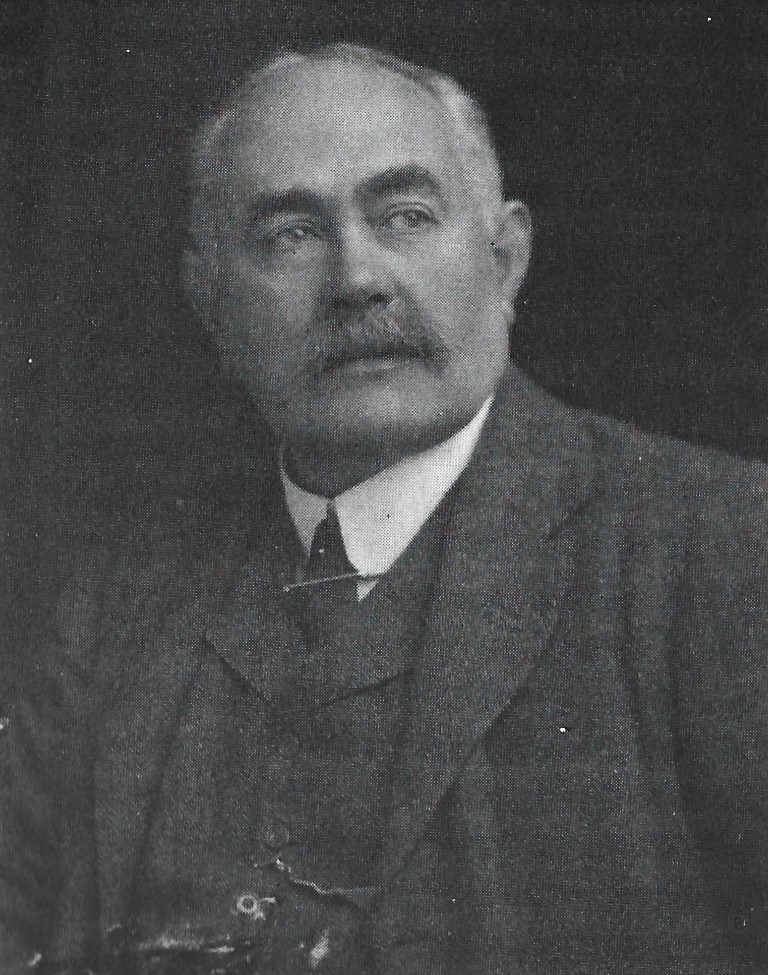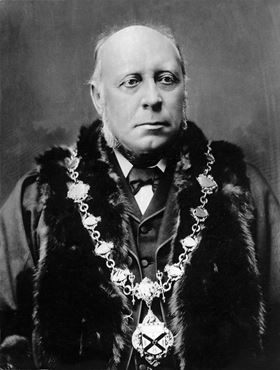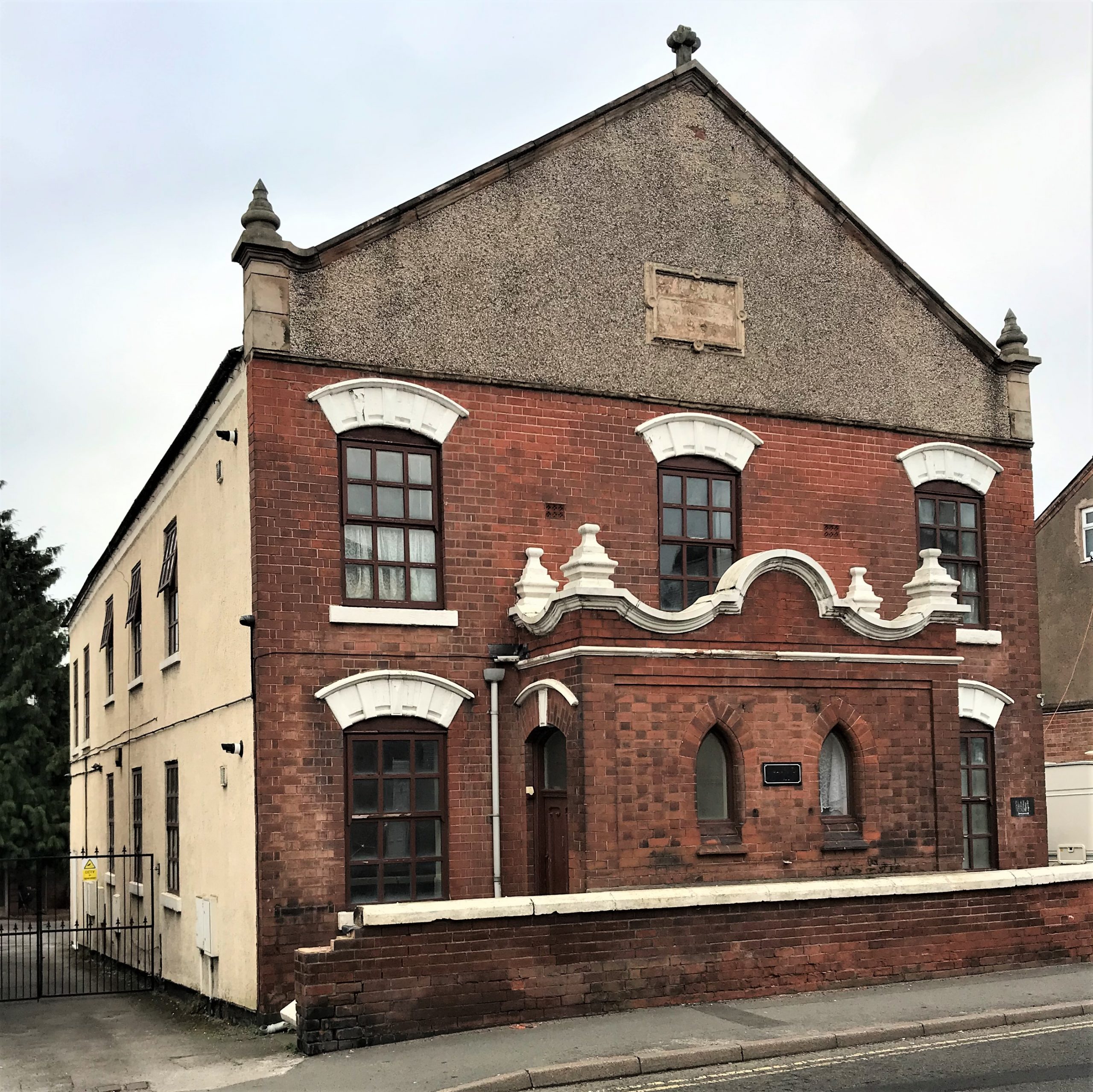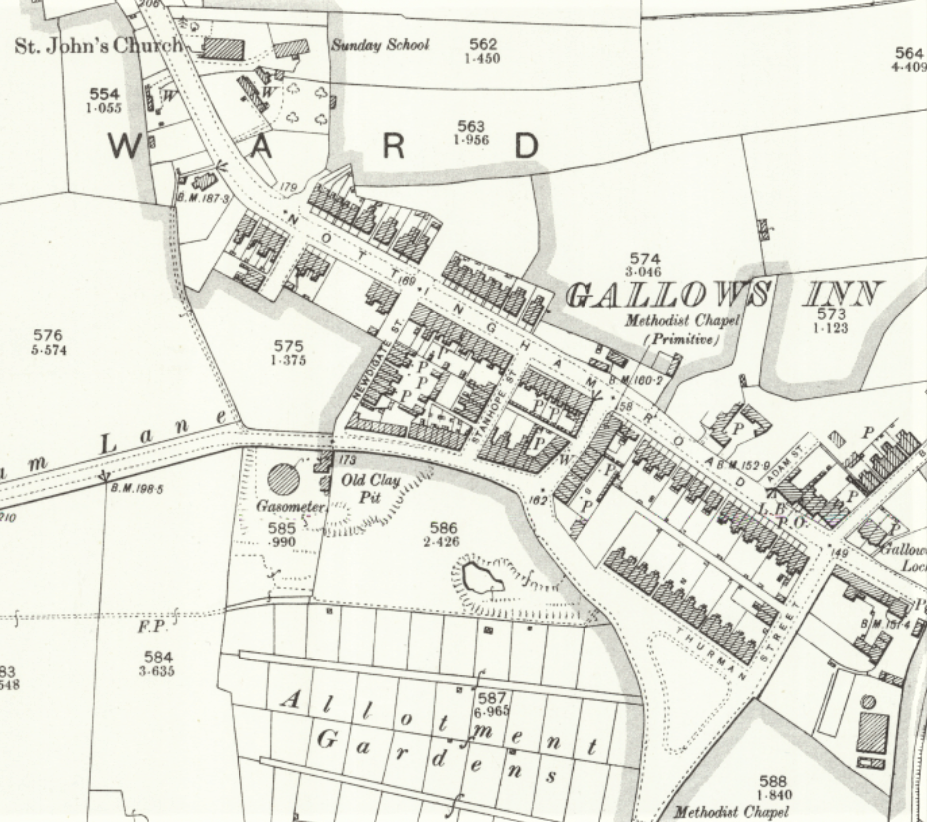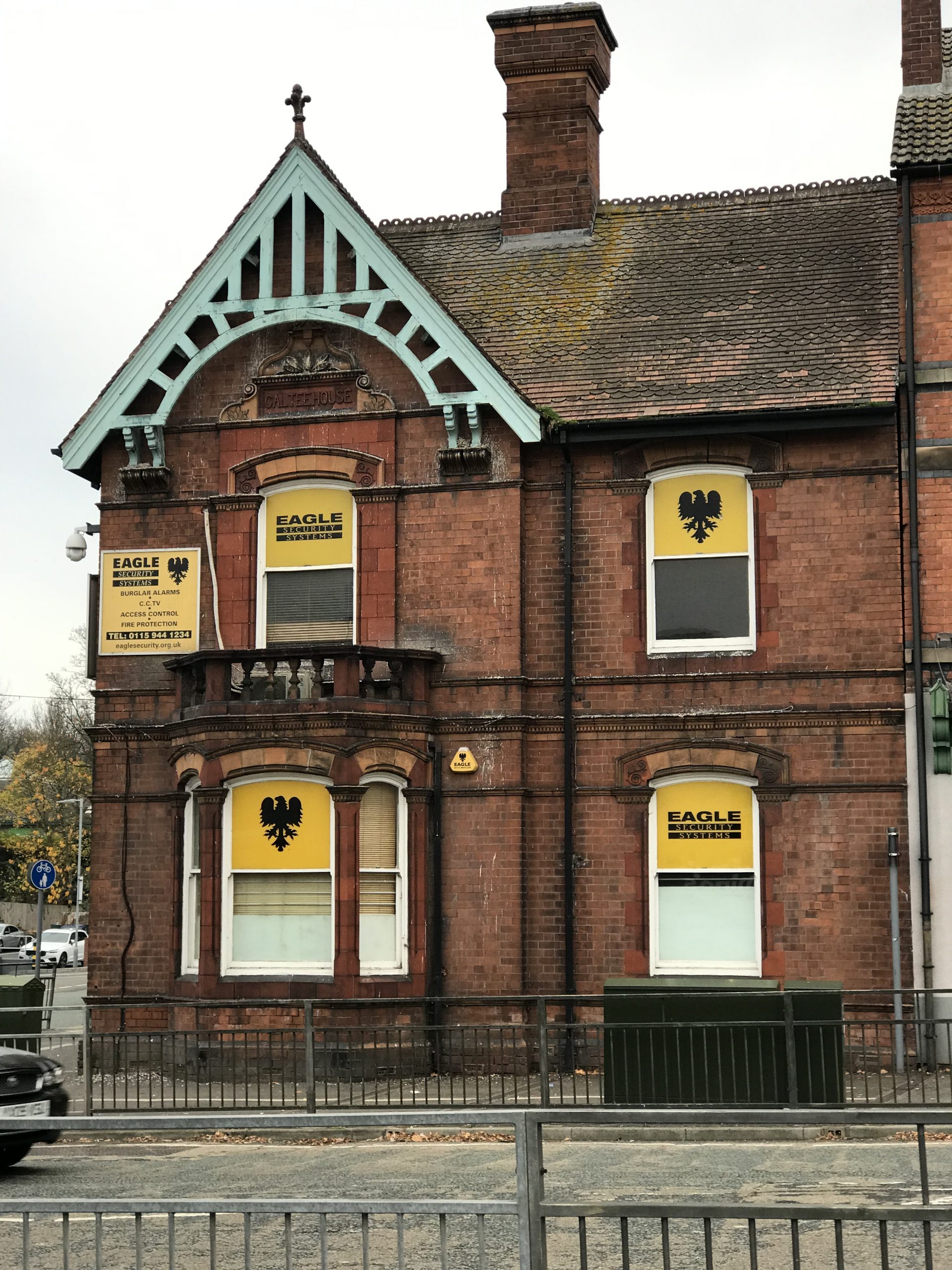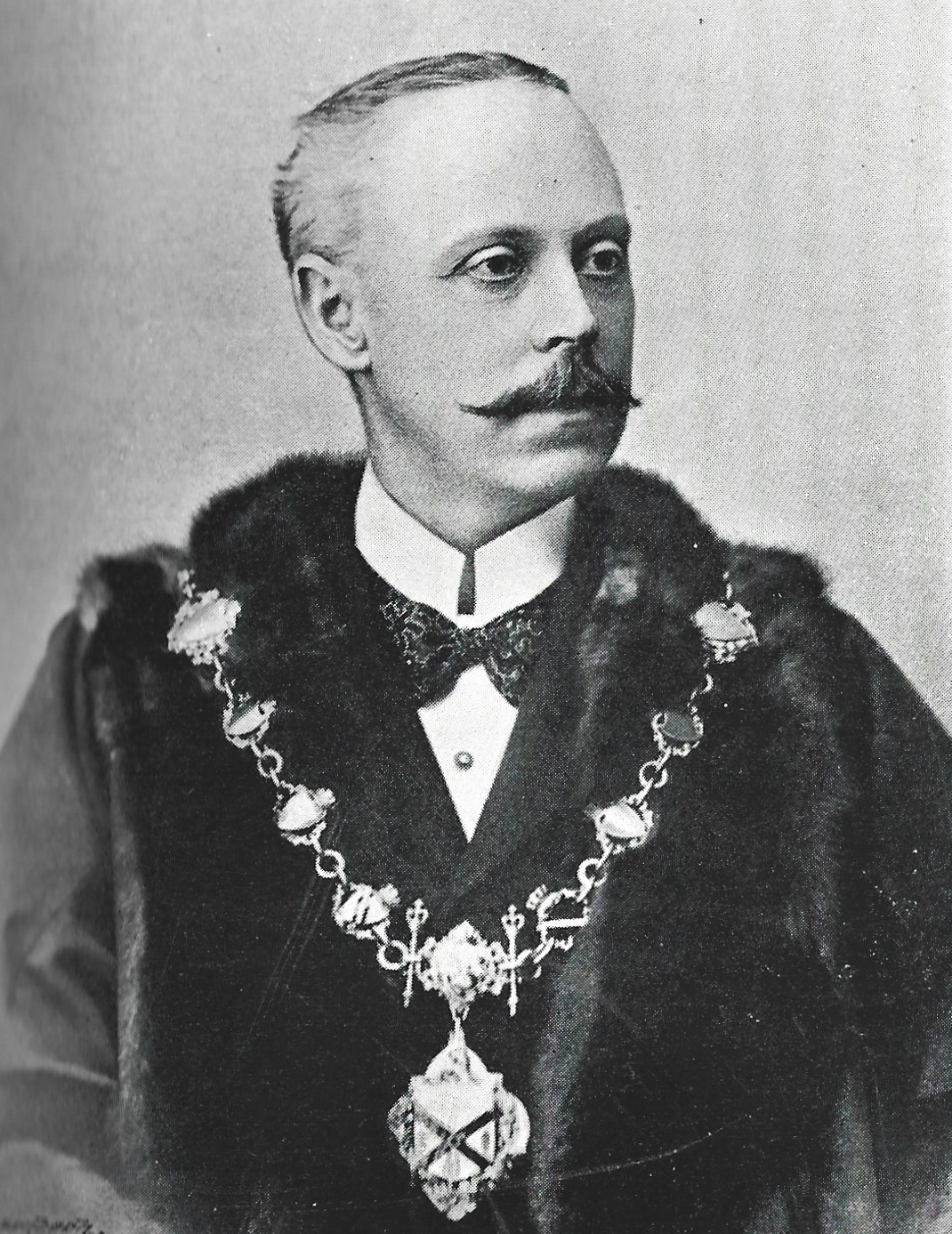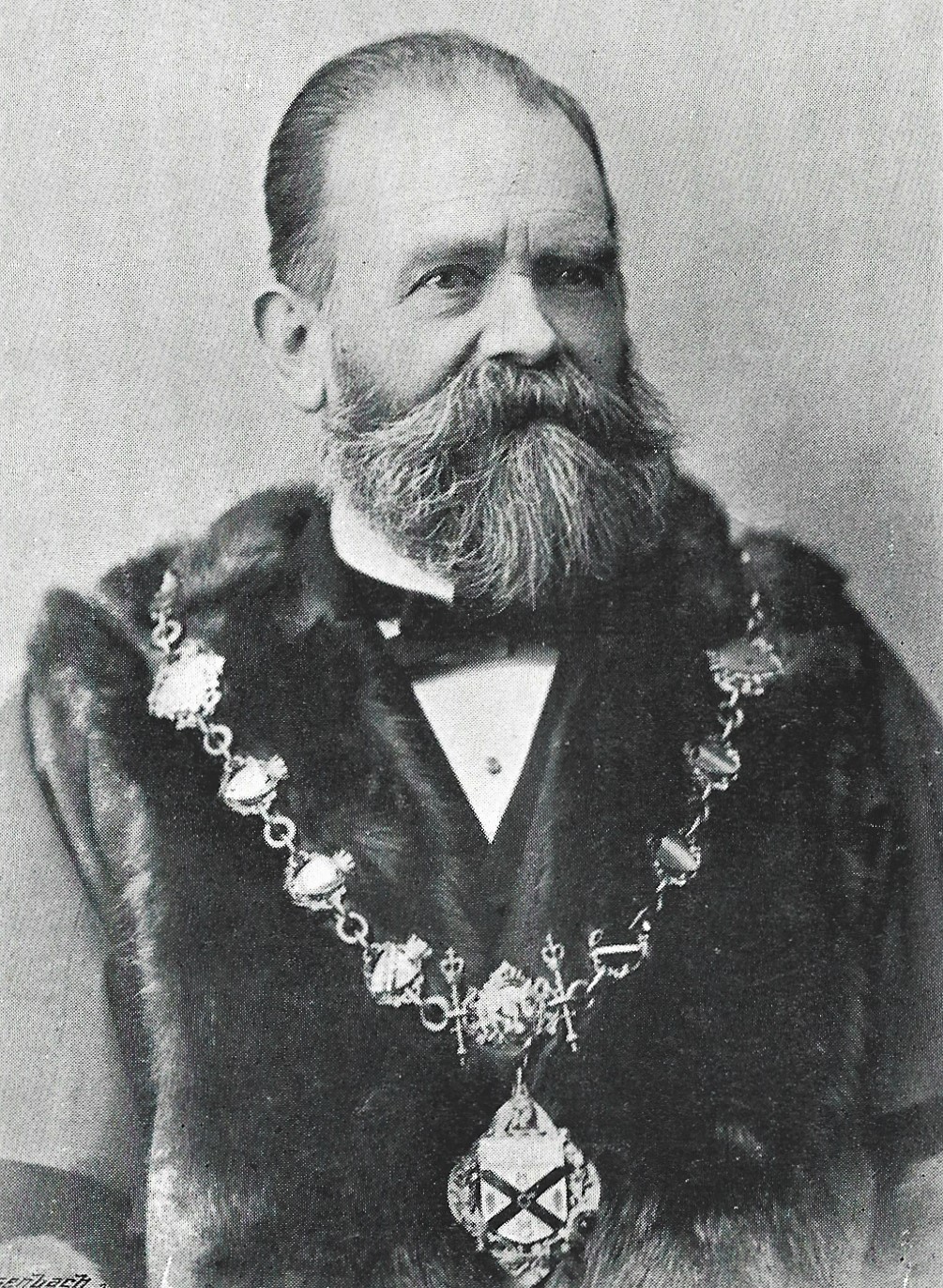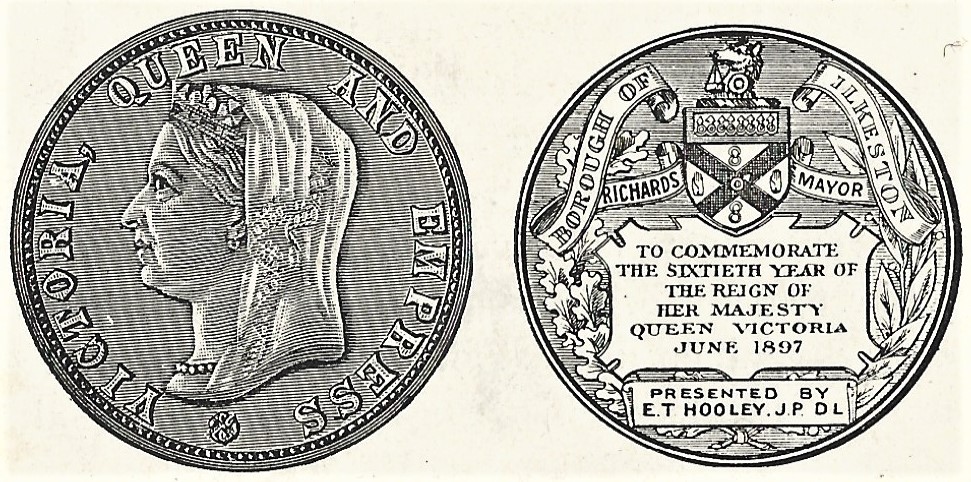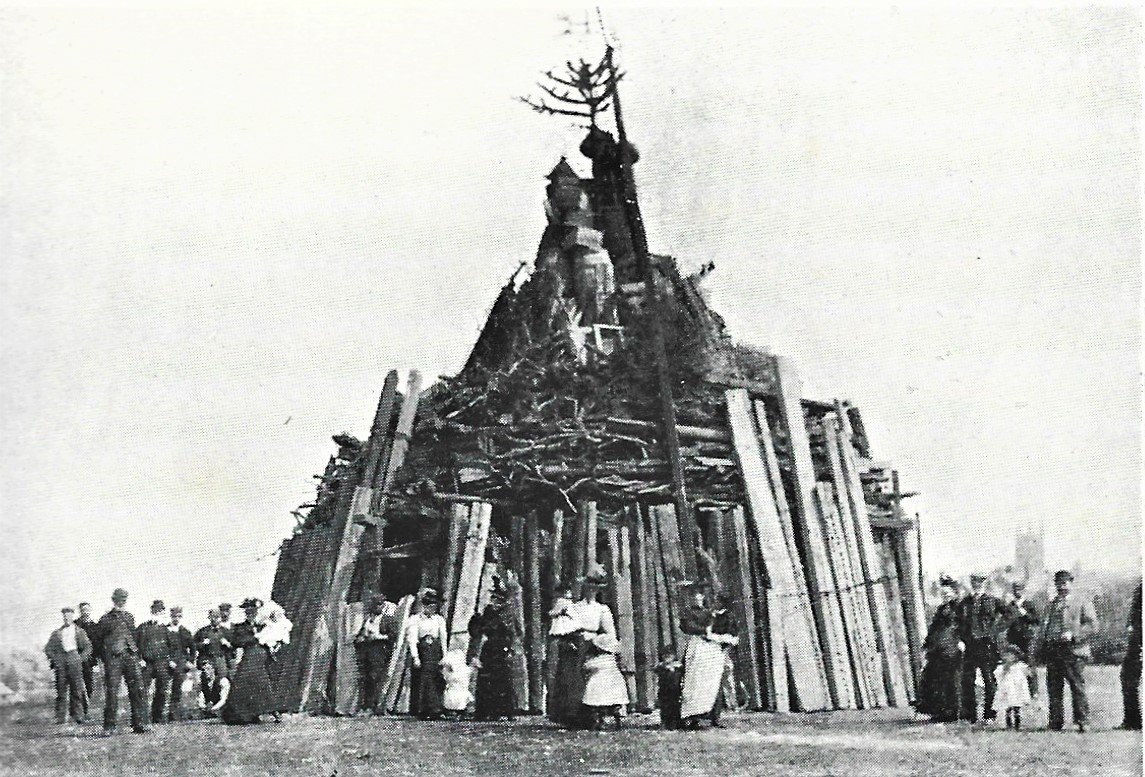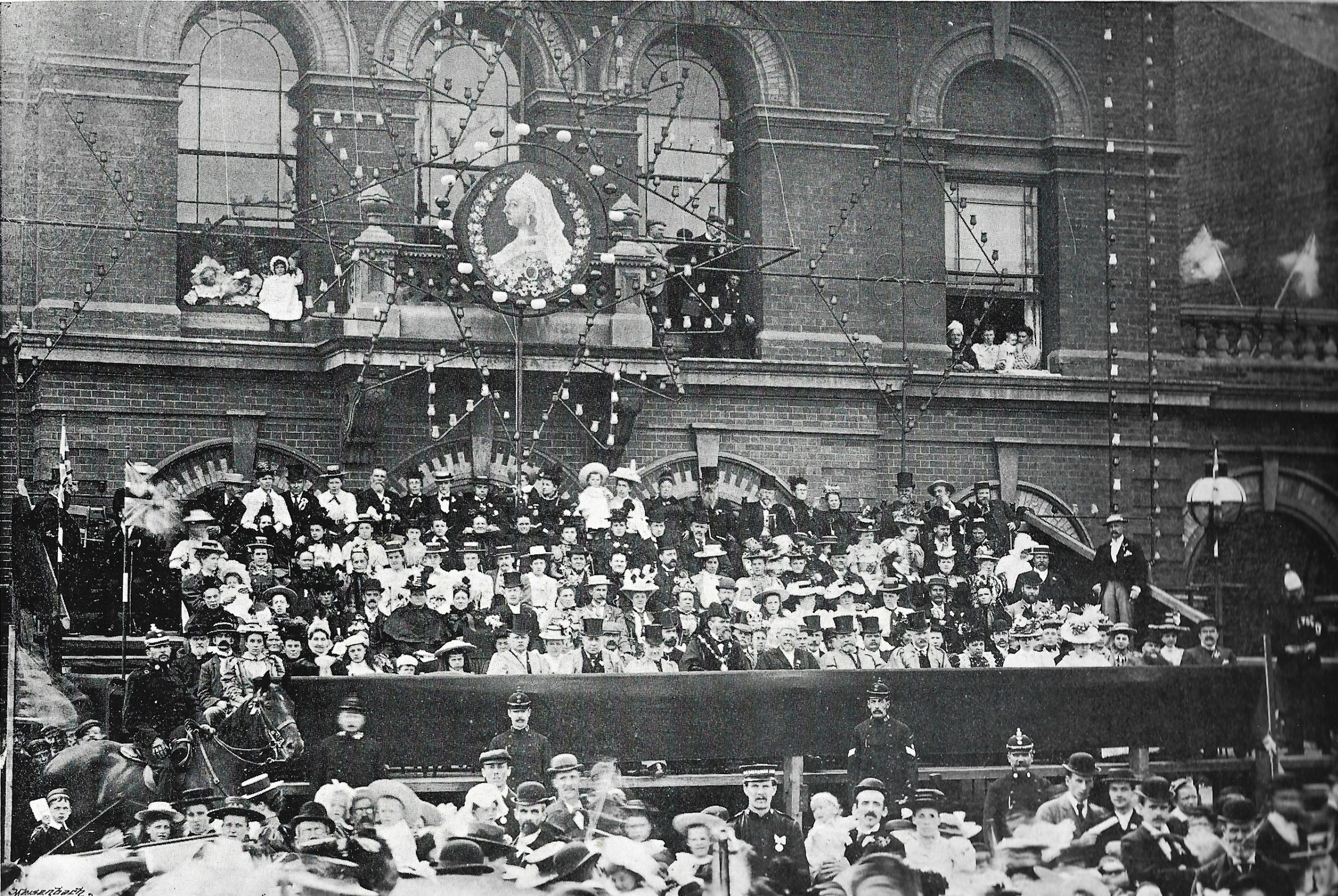the years rolled on ….
————————————————————————————————–
1894
The health of the town: April 1894
By April 1894 the Council’s Medical Officer of Health, Joseph Carroll, was ready to outline his report on the health and sanitary condition of the Borough of Ilkeston for 1893.
He estimated the population at Midsummer 1893 to be 20,930.
Of the deaths in that year, 55% were children under the age of 5.
Deaths of children under 1 year in Ilkeston greatly exceeded the national average, and for the doctor the causes were clear; “want of cleaniness, and wrong, insufficient or excessive feeding. The leaving of children at home in the care of those who are too young and thoughtless or careless with regard to the children”. He went on to condemn the use of cordials and soothing syrups which almost always contained opium or morphia.
Young children’s health was being adversely affected by the dampness of house walls and surrounding soil. Therefore all houses should require an efficient damp course below the floor level, while roofs, spouting and drainpipes needed to be in good repair; drains should have a proper fall and drain joints should be thoroughly watertight; yards needed an impervious covering to carry off storm water or slops quickly before they soaked into the ground.
The existing dampness was causing bronchitis, catarrh, rheumatism, neuralgia and pthisis, possibly diphtheria and throat infections.
Joseph condemned the ignorance of parents. Many believed that children must have an infectious disease during their lifetime, and the sooner the better !! With this belief, some parents intentionally exposed their child to a disease, seemingly oblivious to the fact that the younger an infant was, the weaker it was to fight against infection and so succumb to the consequences. Thus the doctor strongly recommended shielding children from any disease until, at least, they were sufficiently strong to fight against it. And to fight against their ignorance, he advocated holding classes for parents, on Sanitation and Nursing, under the auspices of the County Council or the St. John’s Ambulance Association.
This ‘terrible wholesale slaughter of innocents‘ could be avoided by action on the part of the Council. Without it, the members would be guilty of allowing ‘this wanton waste of innocent lives’. The care of children rested on all of them and they had a duty to act.
During the year Dr. Carroll had recommended two closures of Hallam Fields school (Stanton Iron Works mixed School), one following a serious outbreak of measles in the early part of the year, and then another later, because of an attack of scarlet fever. In both cases the local residents were convinced that the outbreaks were caused by the proximity and offensiveness of the discharge from the sewage farm there. However the latter disease had attacked more severely those parts of Hallam Fields furthest from the farm; the doctor blamed house overcrowding, lack of personal cleanliness, and pollution by slops and sewage as the causes of the fever.
Joseph then discussed the spread of Cholera, and the role of water supply, air, food, disinfection, isolation, hospital accommodation and the removal of house refuse. With reference to that last issue, he advised the abandonment of the tub closet system and the adoption of waste water closets flushing automatically by waste water from the sinks.
Joseph’s zealous advocacy of these issues and changes was to cost him dear in the very near future.
————————————————————————————————–
The new sewage system: June 1894
Time for another public inquiry ??
By June 1894 the Town Council had applied to the Local Government Board for permission to borrow £7500 to finance a new sewage scheme, which of course necessitated a visit from a Board Inspector — in this case, Major-General Henry Darley Crozier. The loan would pay for additional sewers and disposal works. However the loan amount was soon increased by £500 to £8000 when the Council decided it needed to buy two new gas engines to pump up sewage sludge, thereby replacing manual labour.
In 1868 the old Local Board had borrowed £2500 to lay down sewers in the town, though there was no investment in sewage disposal at that time. Then in 1881 and 1885 the same Board had borrowed a total of just over £15,000 to adopt and then improve an irrigation system of sewage disposal. By 1894, of that total debt, about £8500 remained unpaid, but the town now had a complete system of sewers and a new sewage farm at Hallam Fields.
However in 1893 both the Erewash Canal Company and the County Council had complained that some of the town’s sewage had found its way into the canal and the river Erewash — and this had better stop or else !! The Canal Company had even gone so far as to impose a penal agreement upon the Borough Council which had to do something quickly or face a severe fine. The solution was to adopt the ‘Universal’ system of sewage purification, a solution not accepted by the Board Inspector, because the ‘Universal’ system was not recognised as safe. In July the Board Inspector conducting the Inquiry didn’t like the Council’s scheme; there wasn’t sufficient land set aside to pass the effluent over before it was pumped into the River Erewash. The Council therefore agreed to modify its scheme and then come back to the Local Government Board for (another go at) approval …. and come back it did !!!
On January 8th, 1895, before a different inspector, another inquiry was held at which the Town Council presented a slightly modified scheme to the one put forward in July of the previous year. The ‘expensive magnetic carbine filters‘ were abandoned but the ‘precipitating tanks‘ were retained, and much more land in several areas was set aside for dealing with the effluent from those tanks. A decision was expected shortly !!
————————————————————————————————–
And now for something completely different: July 1894
The grounds of the Mayor’s home at Field House were opened for a garden party in aid of funds for the Ilkeston and District Harmonic Society — the Mayor was the Society’s President. “A good company assembled”.
Field House (courtesy of Ilkeston Reference Library)
A cricket match was arranged, between eleven members of the Society and a motley attired team from the Theatre Royal, all ‘very amusing‘; the home team won by two runs. Lawn tennis was also on offer.
The Ilkeston Borough Prize Band led by Tom Wardle was on hand; dancing was encouraged; a phonograph was to be heard, with a large and varied programme; a shooting range supervised by Jacob Hawkins; goods were sold in the marquee; refreshments were provided and the day rounded off with illuminations … all very remote from child mortality, sanitary shortcomings and the town’s sewage system. At least for a while, and for those present.
————————————————————————————————–
Who is to be the Council’s Medical Officer for Health ? Part 1. July-August 1894
And now time for retribution ?
There were two local candidates for this post which paid an annual salary of £100 — Joseph Carroll, the present medical officer, and John Joseph Tobin, a Council member. The issue was discussed within a very heated Council meeting, without any recommendation from the Health Committee and without any reference to either candidate’s testimonials. It would seem that from the outset each member of the Council had his own favourite.
Joseph Scattergood spoke very highly of the way in which Joseph Carroll had performed his duties for several years and had regularly attended their meetings (although, it was pointed out, he was paid to attend !!). John Joseph Tobin, on the other hand, had a sparse attendance record for the meetings of the Health Committee, of which he was a member (though yet again, it was pointed out that he wasn’t paid but it was his duty !!!)
Charles Mitchell questioned John Joseph’s application, as he was already a member of the Council — a conflict of interest ? did he already have a leg in the door ? His position was not improper or unconstitutional however, and he would have to resign as a councillor if chosen to be the medical officer. Charles went on to say the Dr. Carroll had served well when the salary was £35 p.a. but now that it was £100 some on the Council wanted to appoint a different officer; this was mean and beneath contempt.
Up spoke James O’Hara, a member of the Health Committee for four years, who was very critical of Joseph Carroll, stating that the doctor had long been at cross-purposes with his Committee — suggesting that the doctor was, perhaps, ‘too vigorous’. (As we saw, above, Joseph was an enthusiastic sanitary reformer, always keen to point out when he thought the Council wasn’t protecting the health of the community as it should .. or as he thought it should). James O’Hara was of the opinion that the doctor’s policy and approach were not what the town’s ratepayers could afford !! Though councillor Edwin Sutton thought this was an admirable quality in Joseph; he was a fearless and honest campaigner, and they did not want a man to pander to gentlemen who sat round the table.
And all the time there was — as usual — an undercurrent of party politics and family connections colouring the discussion. (For example, Dr. Tobin was married to Ann Eliza Tatham who was the daughter of Herbert Tatham and Ellen Sudbury … and the latter was the sister of the Mayor !!)
A vote was taken and Joseph Carroll was ousted as Medical Officer of Health — by 10 votes to 9.
The preferred candidate, John Joseph Tobin (courtesy of Ilkeston Reference Library)
But that wasn’t the end of the matter. An open-air meeting in the Market Place was held on August 8th before a crowd of about 1000. Councillor Edwin Sutton supplied a dray on which stood the said councillor plus Joseph Scattergood, Charles Mitchell, Edwin Trueman and, acting as chairman, William Holmes, late landlord of the Old Harrow Inn — all leading the protest against the appointment of Dr. Tobin, and the domination of the town’s affairs by two or three influencial families. (Who could they mean ??). Dr. Carroll had done his job ‘too well’ and had been driven out of office as a consequence.
Joseph Scattergood then proposed a motion of confidence in Dr. Carroll and condemning the actions of the Corporation in dismissing him, the results to be forwarded to the Government Local Board. No voice was heard in opposition, no hand was raised against it.
Three cheers for Joseph Carroll !!!
And make the most of this occasion — it wasn’t often, if at all, that Edwin Trueman stood on the same platform and agreed with Councillors Mitchell and Scattergood !!
The Local Government Board replied promptly, signalling its approval of the appointment of Dr. Tobin.
But this wasn’t the end of the end of the matter !!! On January 7th 1895 Dr. Carroll was invited to a reception at the Rutland Hotel where he was presented with an illuminated address and a purse of gold, to “express deep sympathy with Dr. Carroll in the unfair treatment he had received at the hands of a bare majority of the Town Council”. Members of the losing minority were present … Councillors Isaiah Fisher, Edwin Sutton, Edwin Hall and Edwin Trueman, as well as ironmonger George Andrew, William Holmes, butcher William Barnes, Arthur Holmes of the Durham Ox, and Robert Robinson, music dealer of Bath Street.
And a couple of months after this, at the beginning of March 1895, Dr. Joseph Carroll actually won an election … this one was for Ilkeston’s Southern Division of the Derbyshire County Council where he defeated George Haslam. And would you believe it, but in the Northern Division, Dr. John Joseph Tobin was re-elected, fighting off opposition from Isaiah Fisher.
But this wasn’t the end of the end of the end of the matter !!! On June 21st 1895 someone broke into Dr. Carroll’s Bath Street house and stole £16 10s from a purse locked in a bedroom drawer. This was the purse and the money presented to Joseph in January.
————————————————————————————————–
A new mayor: November 9th 1894
Alderman Frederick Beardsley, nominated by Samuel Robinson and seconded by George Archer, was chosen to be the Mayor of Ilkeston for 1894-95 but not without a fight !!!
Also nominated for the post, by Charles Mitchell and seconded by Joseph Scattergood, was Alderman Samuel Richards who had seemingly been unofficially offered the post prior to the election. The ‘spectre’ of Dr. Joseph Carroll’s recent removal as the Council’s Medical Officer of Health loomed over the whole issue. It was claimed by none other than Edwin Trueman that many electors in his South Ward had voted in the recent Municipal elections in support of the Doctor, and as Samuel Richards had vehemently supported Dr. Carroll, then Edwin now felt the need to represent the ratepayers of the South Ward and support Samuel.
The arguments continued for some time, with other councillors adding their views, although all of them were agreed that both nominees were worthy to hold the office. At last, and worn out by the arguments over him, Samuel declared that he would not accept the post even if it were now offered to him; his name should be withdrawn. Councillor Isaiah Fisher rounded off the discussion (with tongue in cheek) by stating that it was about time the town had a Conservative Mayor. But not quite yet !!!
Being a Cotmanhay lad, Frederick was in the habit of attending the chapel on Cotmanhay Road (its foundation stone laid in 1867), and so on the Mayoral Sunday following his induction, he took the Council along to his chapel … along with the School Board, several magistrates, solicitors, police officers, members of the Volunteer Fire Brigade, etc.. They all met at Wesley Street school and then paraded the short distance down to the chapel.
This made a change from using the Independent Chapel in Pimlico or the Parish Church, as in the past, and it was the first time that Cotmanhay had been ‘honoured’ in this way. Consequently its inhabitants turned out in force to witness the procession, and the small chapel was packed to the rafters. A large choir and orchestra were on hand to enhance the occasion.
Also in November the Council elections resulted in the return of two Tory Councillors for the South Ward — Edwin Trueman and Horace Moss — for the first time in its history, largely because the Stanton Ironworks voters turned out almost solidly for the Conservatives. In the Central Ward, Edwin Sutton retained his seat while George Archer, of the Liberal Association, beat several candidates for the vacant seat previously occupied by Samuel Robinson who had just been elected an alderman. In the North Ward the nomination papers for one of the retiring Liberal members, William Sleath, were considered invalid and so he was disqualified –this let in Isaiah Fisher to be elected, alongside Samuel Bloor.
The net result was that the Liberals lost three seats though they still retained a majority.
————————————————————————————————–
1895
Gas improvements: 1895
By June of 1895 the Town Council needed another loan — of £4000 — for its proposed improvements to the town’s gas supply. Time for the ‘begging bowl’ once more .. and for another public inquiry !!!
A new gas main: If we look back about 40 years, to the town in the 1850s, we can see that there had been much discussion about Ilkeston’s street lighting. At that time, one of the first gas mains laid by the old Gas Company was the one in Bath Street which ran from the Gas Works in Rutland Street up to the Market Place — and as it made its way ‘uptown’ its diameter decreased. It started off as an 8in pipe, then decreased gradually by an inch each time, until it was only 4in at the top of the street. The reasoning was that there were fewer houses to supply as the route progressed, and therefore no need for larger pipes. And the pipe which continued down South Street (and was as old as the Bath Street one) was alsoonly 4in in diameter.
These gas mains were now past their ‘sell-by’ date and the Council proposed a new 12in pipe for Bath Street and a 6in one for South Street
The Hallam Fields Issue: The Stanton Company had made an offer to supply gas to every house in Hallam Fields and to pay for the consumption with a lump sum …. so long as the Town Council laid the gas mains in the streets there. The Gas Committee of the Council had rejected this offer and Wright Lissett, the Clerk, had to explain why this seemingly generous offer had been refused, to the rest of the Council. His reason was that the Gas Committee did not lay gas pipes in streets which were not public or had any reasonable possibility that they would become public. For example, if a pipe needed mending in a private road, the Council would need permission before it could access the problem. Edwin Trueman pointed out that about 150 houses were affected — surely the Council could lay mains in the streets ?!? The Clerk replied that they would gladly do this in public roads and then supply a large meter to the Stanton Company for their houses. This seemed a sensible proposal to the majority of the Council members and so plans were made !
A gas main would be laid in Corporation Road to supply the Hallam Fields residents. This road had been built in 1888 and the area now had a population of about 600 – 700 folk who thought it time for them to be treated like the rest of the town. Because of the topology of the town it was impossible to pass gas from Rutland Street, up Bath Street, and then down Nottingham Road and then around Hallam Fields without the risk of leaks resulting from the pressure needed to do this. So the Council would supply the area from a gas holder placed in Hallam Lane, on land leased from the Duke of Rutland, and then run a 6in pipe to Hallam Fields. Around Hallam Fields, 5in, 4in and 3in pipes would be used. Fortunately the Council had an old holder at the gas works which was too small and now practically useless for the rest of the town. It could be used on Hallam Lane, thus cutting down the overall cost of the scheme. The holder would be filled up during the day, and then the gas would be used at night, to supply Hallam Fields and part of lower Nottingham Road. At Hallam Lane new buildings would be erected to house the engine, the exhauster, tools, etc. and a caretaker’s house.
The old Gas Holder on Hallam Lane in the late 19th century
Changes to the Rutland Street Works: Once the old holder had been removed from the Rutland Street works, a new larger, 100,000 cubic feet holder could be built there (The old one was only 36,000 cubic feet). The other holder at the works had a capacity of 200,000 cubic feet which would be extended by an extra 100,000 cubic feet. Altogether this would give the town an extra 240,000 cubic feet of storage (almost).
In the winter time, because of limitations at the works, it had been discovered that sufficient gas of an illuminating power to satisfy customers could not be produced. So, an ‘enrichment plant‘ had been built there (already !!) to increase the gas’s illuminating power … and what a great success this had been. But it now needed paying for.
The total cost: the Town Council had totted up all this expenditure and presented a total bill of £3990 17s to the Local Government Board Inspector, Mr. Codrington, who was at the Town Hall meeting on June 14th, to assess the scheme and the loan. Frederick Chilton Humphrys, the manager of the gas works, was on hand to explain all the technicalities and diagrams. After that the Inspector wandered off to inspect the works and ponder the loan.
————————————————————————————————–
Who is to be the Council’s Medical Officer for Health ? Part 2. August 1895
Dr. Tobin had resigned as Medical Officer for Health and so, at the August monthly Town Council meeting, the question of who was to succeed him was discussed. And once more the appointment raised much heated discussion. (It was the health concerns of his wife, Ann Eliza, which caused John Joseph Tobin to resign)
The Health Committee recommended Dr. James George Willis, who had filled the post pro tem. Most of the members, led by Alderman William Tatham, were willing to back the Committee’s view and it was almost passed unanimously — until Edwin Trueman stepped in !! An application for the job from Dr. Carroll had been received by the Council and Edwin couldn’t understand why it had been so easily overlooked and/or rejected — what had he done to lose the confidence of the Council ?? The doctor had previously served the town for ten years and yet they were now willing to appoint someone who had only been in the post for three months. The choice was between experience and inexperience, explained Edwin, and once again, he reminded them all of the charge of nepotism which had arisen the last time the post was filled. (And do I need to remind you that Alderman William Tatham was the uncle of Dr. Tobin’s wife ??!!).
At this point several other members of the Council spoke up in favour of Joseph Carroll, and many of the arguments heard previously, a year before, were aired once more. Joseph Scattergood, Edwin Sutton, Isaiah Fisher and Charles Mitchell stressed Joseph’s qualifications and his fearlessness in carrying out his responsibilities; Samuel Wood, Richard Hunt and George Archer were wary of Joseph’s zeal in advocating improvements which the town could not afford.
Eventually a vote was taken and Dr. Willis was appointed, by 13 votes to nine.
If you are interested in the minutiae of these petty local Council disputes, the 13 votes for Dr. Willis came from Mayor Frederick Beardsley, Aldermen William Merry, Samuel Robinson, Francis Sudbury and William Tatham, Councillors George Archer, Samuel Bloor, Benjamin Gregory, George Haslam, Richard Hunt, Enoch Limb, James O’Hara and Samuel Wood. The nine votes for Joseph Carroll were cast by Alderman Samuel Richards, Councillors Nathan Buxton, Isaiah Fisher, Edwin Hall, Charles Mitchell, Horace Moss, Joseph Scattergood, Edwin Sutton and Edwin Trueman.
In August 1896 Dr. Willis was reappointed as the borough’s medical officer for a further three years, an appointment sanctioned by the Local Government Board.
Galtee House at the junction of Heanor Road and Manor Road. Built for Dr. Willis in 1897, “the distinctive building was built on the proceeds from a series of successful bets on the race horse Galtee More”. (The doctor was born at Abbeyleix in County Laois)
————————————————————————————————–
A Conservative Mayor ?? Whatever next ??!! : November 1895
A double first for Charles Maltby — the first Conservative Mayor of Ilkeston, and the first one who was not an Alderman but a Councillor. He was elected unanimously.
At the same time Aldermen William Merry, Samuel Robinson and Samuel Richards had all served their six-year terms in that office and had to retire. Three more Aldermen now had to be elected — and the three ‘retirees’ were re-elected !!
Charles Maltby, son of Joseph and Mary (nee Barker), wasn’t an Ilkeston man, but had been born in Nottingham on March 16th, 1848. He had married Eliza Ann Long, daughter of John Potter Atkins Long and Elizabeth Batt (nee Milsome) on April 7th, 1871, and had lived in the town for almost 30 years.
A prominent lace manufacturer with a factory at the junction of King Street and Station Road, he and his family had lived at Dalby House since about 1887.
He had been a member of the old Local Board for five years, and had represented the Central Ward of the Town Council (not uninterrupted).
Charles had also served on the School Board, and was a prominent Freemason of the Rutland Lodge, an overseer of the poor, and a churchwarden at the Parish Church, where Charles’s Mayoral Sunday service was held.
On April 7th 1896 the silver wedding of the Mayor and Mayoress, and the coming of age of their eldest son Charles Percival, were celebrated by a Town Hall banquet, catering provided by Edwin Hall of the Rutland Arms Hotel, ‘of the most ample and recerché character’.
————————————————————————————————–
1896
The saga Dr. Tobin’s seat: June 1896
As a post script to Dr. Tobin’s re-election onto the Derbyshire County Council, his wife’s illness forced her to take a prolonged convalescence in the south of Europe for a change of climate, and John Joseph chose to be with her. By June 1896 he had thus been absent from his County Council duties for over a year, and by Act of Parliament he had to be replaced as a Councillor. The doctor objected and explained the reason for his absence …. unfortunately for him, he could use illness as an excuse only if he personally was the one who was afflicted. He therefore had to relinquish his place on that Council.
But this wasn’t the end of the end of the end of the end of this matter !!!! Through incompetence, the County Council incorrectly declared the seat in the Southern District of Ilkeston to be vacant (i.e. Dr. Carroll’s seat) and not the Northern District seat (Dr. Tobin’s seat). The Ilkeston Mayor Charles Maltby and the Town Clerk Wright Lissett rushed over to Derby to sort out this mess, only to find that the County Council officers were all on holiday !!! (You couldn’t make it up could you ??). Eventually the Notice of Vacancy was withdrawn, meaning that Dr. Tobin retained his seat … and he made it clear that if anyone challenged this he would take them to the law court !! (Messrs Thurman, Cattle and Nelson were ready and on alert !!)
Meanwhile, (tongue in cheek ?) the Ilkeston Liberals chose a candidate to fight any possible election in the Northern District. It was also pointed out that Dr. Tobin hadn’t been absent for 12 consecutive months and so couldn’t be deprived of his seat (according to the Municipal Corporations Act 1835 (adapted)). Had the predominantly Conservative County Council just used Dr. Tobin’s absence as an excuse to get rid of him, a Liberal, on the council ??
Ilkeston’s Liberals were having none of this. At the Liberal Club in the Lower Market Place they unanimously passed a resolution — “That the blundering attempt of the Tory party on the Derbyshire County Council, as advised by their clerk, Mr. Hughes Hallett, to declare Dr. Tobin’s seat vacant, is both contemptible and illegal; and this Association is prepared to support Dr. Tobin in any action he may be advised to take to retain his seat”.
Dr. Tobin appealed the County Council’s decision to unseat him; the case came before the Royal Courts of Justice in London which concluded that, at every step of the procedure, the County Council had acted outside the law. Dr. Tobin retained his seat and the Council was landed with a rather large bill for costs.
————————————————————————————————–
The Socialists cometh: November 1896
The municipal elections of this year were notable as the first time that the three Ilkeston Wards all fielded a Socialist candidate … H.Dexter (North Ward), Harry Silburn, bootmaker and seller (Central Ward), and Henry Hodgett (North Ward).
Not one of them scored a century .. in votes !!!
During the campaign there were very few public meetings, except by the Socialist, hardly any mural postings … all electioneering seems to have been done via the press or with personal canvassing.
Samuel Richards, a nonconformist Conservative, and wholesale grocer and provision merchant of Cotmanhay Road, was later unanimously chosen as Mayor for 1896-7. He had begun his working life as a mining contractor like his father Samuel senior. However, at the age of 22, a serious accident while sinking a mine shaft, cut that work short. He had been on the Local Board since 1884, on the Town Council since May 1887, and was elected an Alderman on the death of Alderman John Moss in 1894.
Samuel’s Mayoral service was held at the Ebenezer Chapel on November 15th, 1896. He was accompanied there by the Cotmanhay Brass Band, members of the Corporation, the School Board, the Fire Brigade and police, The ensemble had processed from Holy Trinity Church.
————————————————————————————————–
1897
Another side to the Town Clerk: June 1897
The annual Ruridecanal Conference was held at West Hallam on June 1st, and it was there that Wright Lissett read a paper on “the Promotion of Kindness to Animals“. He advocated an increase in the number of officers available to the R.S.P.C.A., “a step in the right direction”, and the prohibition of the “reckless shooting of wild birds“. He moved that “The promotion of kindness to animals is worthy of every attention, and care should be taken to mention its importance in sermons, addresses in schools and at children’s services, and also by the distribution of leaflets”. The resolution was carried.
————————————————————————————————–
Victoria’s Diamond Jubilee; June 1897
The Diamond Jubilee celebrations for the Queen, on June 22nd, were fast approaching.
Victoria’s Coronation had taken place on June 28th, 1838 though she had become Queen on June 20th, 1837. An old Ilkestonian vividly remembered that Coronation day in the town, when he was just a very young Sunday school lad. There was a parade of the town’s schoolchildren on the old cricket ground to the immediate south of St. Mary’s church — where now stood St. Mary’s National schools, factories, institutions and some housing. At that time the ground had only just been laid out and wasn’t fully turfed over; in fact heaps of turf lay around, waiting to be put in place. Each participating child received a giant bun — so big that it was difficult to take it safely home !! “Of the hundreds who shared in the proceedings of that day, how few remain !”
Trueman and Marston recall that 1300 children then marched in procession to the square facing the White Lion Inn, headed by a banner inscribed “Raikes and Sunday Schools”. After some joyful and patriotic singing, the procession made its way through the town and down to the Rutland Arms Hotel and more singing. Later the children adjourned to play on nearly fields and were fed mountains of plum cake. Finally they were all presented with a bun, courtesy of the Duke of Rutland Lodge of the Independent Order of Oddfellows, Manchester Unity, as they passed two abreast through a beautiful archway of green boughs, surmounted by a banner inscribed “Long live Victoria”.
And now, in 1897, 50 years later, similar events were being planned by the Town Council. The combined Sunday schools of the town were to meet at 2p.m. on the afternoon of Tuesday, June 22nd, and sing patriotic songs and hymns, accompanied by five different bands. Each child had been allocated 6d by the Corporation for a tea — this was to be held in the different headquarters of each school. And after tea the children would be off to play in various fields around the borough, and look forward to being presented with a medal in remembrance of the occasion (below), financed by Ernest Terah Hooley J.P. of Risley Hall.
At the other end of the age scale, the old people of the borough would be treated to a tea during the week leading up to the special day. The “drinking populace” was also to be catered for; despite opposition from Joseph Scattergood and the Temperance Party, the local magistrates granted an extra hour ‘opening time’ for most of the inns and beerhouses in the town.
At night the Town Hall would be illuminated with a new design while a bonfire (below) would be lit on the “new park”, eight acres of open land, donated by the Duke of Rutland as a Jubilee gift and later named as “Victoria Park”.
from Trueman and Marston (1899)
Everything proceeded as planned and on the afternoon of Tuesday, June 22nd, the Mayor, Corporation and invited guests gathered on a large platform, constructed in front of the Town Hall, to face a large crowd of interested Ilkestonians (below). No speeches were made, just the singing of a hymn and the National Anthem, accompanied by the Borough Band.
from Trueman and Marston (1899)
————————————————————————————————–
Strapped for cash: August 1897
As usual the Council still had very ambitious plans for the town but insufficient funds to finance them all. It now needed over £30,000 and as its borrowing powers from the Local Government Board were significantly ‘circumscribed’, it was decided to lay before Parliament a Private Bill allowing the Corporation to borrow that amount. If we break the total loan down, into its parts — £3850 was needed for the building of a chapel and other premises at Park Cemetery; £1600 for laying out and fencing around the brand new Victoria Park; £4000 to enlarge the Market Place and its buildings; £24,000 for new engines, mains, pumps and shafts to improve the town’s water supply; total £33,450.
The Ilkeston Corporation Bill finally received Royal assent in July 1898.
Samuel Richards, Mayor of Ilkeston once more: November 1897
On November 9th Samuel was re-elected as mayor; there were no dissentions.
————————————————————————————————–
And so we arrive at the Final Issues 1898-1901

